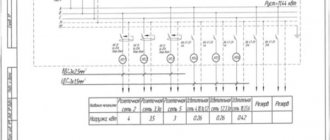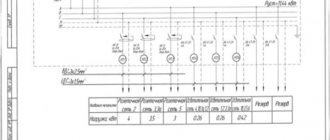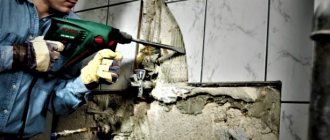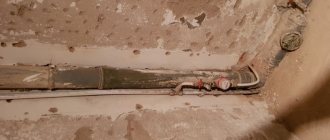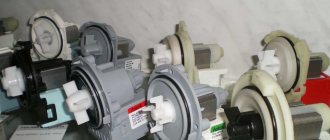A heated towel rail is an important element that no bathroom can do without. It not only complements the interior, but also performs a heating function, and you can also dry clothes or towels on it. The heated towel rail is located in a humid environment, so it periodically becomes unusable and requires dismantling. Replacing a heated towel rail in a bathroom can be done with your own hands. To do this, you need to familiarize yourself with the sequence of work.
Choosing a new heated towel rail
There are different types of heated towel rails. Each option has different costs and features. They sell three types of coils:
- the water type is represented by a curved coil, water moves inside it;
- electrical devices operate from the network, they are installed not only in bathrooms, but also in the kitchen or hallway, the disadvantage is the expense of paying for electricity;
- the combined type is capable of functioning both on a water basis and from the network.
A water-based heated towel rail is used more often than other designs. Such a device is characterized by a longer service life and has a more economical cost. Moreover, it is the water heated towel rail that provides the maximum amount of heat. It is better to start dismantling when the heating is turned off. But if an emergency occurs, the structure can be replaced at any time. You can install an electric heated towel rail for the bathroom; professional advice will tell you how to do this.
Domestic heated towel rails have a larger diameter compared to imported ones. Foreign products are characterized by a rich variety. There are not only different color options, but also shapes. In assortment:
- MP-shaped design;
- M-shape;
- U-shaped option.
Convenient staircase-shaped design. When choosing the shape of a new heated towel rail, you should pay attention to its size. The fittings must withstand pressure from 6 to 10 atmospheres.
It is desirable that the pipes have an anti-corrosion coating on the inside. When purchasing imported water and electrical products, you should ask the seller whether the model is intended to work in Russian conditions. The most reliable is chrome plating and polymerization. There are also options with an aqua guard system. Painting is a less reliable option. If you follow the recommendations, installing a heated towel rail in the bathroom will not cause any difficulties.
Selection by material of manufacture
How to properly remove a heated towel rail is not the only thing you should familiarize yourself with before purchasing a new model. It is also important to understand what material is at the heart of the future device, as well as which option is a priority. In the production of water heated towel rails, the following are usually used:
- black steel;
- stainless steel;
- non-ferrous metals.
Among the latter, aluminum, copper and brass should be highlighted. On sale you can find polished, chrome-plated and painted coils. If the homeowner decides to change the heating device, he should be interested in which material is better to choose. For example, appliances made of steel, which are an alloy of various elements with iron and carbon, are reliable and durable. Structurally, they are almost no different from their conventional stainless steel counterparts.
Steel radiators conduct heat quite efficiently and are coated on the outside with a layer that protects against corrosion. Iron coils are considered the most budget option. They are ideal for those who want to save money. These heated towel rails, however, have their drawbacks. One of them is expressed in a short service life.
If you are looking at stainless steel heated towel rails, you should know that these units are reliable and ready to last for a long time. The main advantage of such coils is that stainless steel can withstand high pressure, in addition, it is resistant to corrosion.
Copper and brass products are the golden mean between other devices. The material has an attractive golden color. It does not corrode, but costs a little more than its stainless steel counterparts. The maximum permissible pressure that such a device can withstand is 6 bar. This feature indicates that the device is well suited for installation in private homes, where the water pressure usually does not exceed 3 atmospheres.
Stages of replacing a heated towel rail
Before you get started, you need to learn how to change a heated towel rail in the bathroom with your own hands. Dismantling the heated towel rail is carried out in several stages. Basic steps:
- dismantling the old structure;
- installation of a jumper, its diameter must be no less than that of the supply pipe;
- ball valves are fixed at the junction of the pipe and the new coil;
- connect the riser;
- to finish work.
The pipe can be masked to give an aesthetic appearance. To do this, use a plasterboard box or plastic panels. If you are planning a major renovation of the bathroom, then the liner can be hidden in a groove that makes its way into the wall. You can also make a box in the shape of a bedside table, inside which shelves are installed. Replacing a heated towel rail in the bathroom with your own hands is quite simple if you know the steps and features of the work.
We recommend: Types of heated floors
Briefly about the main thing
Bathroom heated towel rails are made from various metals. This determines the permissible pressure that can be created inside the product.
The heat source can be electricity, hot water supply or a heating system. Depending on this, it is necessary to pull a cable with a terminal socket or install connecting circuits between the riser and the equipment.
The choice of dryer is based on material, coolant and size. The latter is justified by building codes, according to which it is necessary to maintain specific distances to plumbing fixtures, floors, and furniture.
There are several schemes for connecting units: lateral, diagonal, horizontal (top or bottom). In the case of liquid coolant, it is important to monitor the location of the outlets on the riser in relation to the pipes on the heated towel rail. They should be straight or with vertical inserts, but without loops. Then the independent circulation of water will not be disrupted and air will not form in the system.
When replacing a water heated towel rail, you must contact utility services to turn off the riser and obtain permission to install the selected model. Not always, but in some cases, drafting and approval of project documentation is required.
Proper preparation is the key to success
Dismantling a heated towel rail requires preliminary preparation. First of all, you need to coordinate your actions with the institution responsible for the water supply. Then they start purchasing tools and materials.
Immediately before starting work you will need:
- shut off the supply of hot water;
- in the basement, find a return valve and release the water;
- remove the old structure by unscrewing the nuts or cutting it off with a grinder.
To work you need to prepare special tools:
- welding machine;
- pipe cutting equipment;
- wire cutters;
- fitting;
- fixing elements;
- Ball Valves.
Before starting installation, you should make proper calculations. The new heated towel rail should be located at a distance of 35 cm from the wall with a diameter of 23 cm; if the diameter exceeds these parameters, then a space of 50 cm must be provided. The structure should be 2 meters away from the hot water supply riser. Make marks on the wall with a pencil in the places where the mounting holes will be made. Holes for the system are made using a drill, then plastic dowels are inserted into them.
When starting work, you need to soberly assess your capabilities and calculate the power of the system. Mistakes can have serious consequences. If you plan to replace the entire structure with your own hands, you need to have the necessary equipment, and most importantly, be able to use it. Expert advice will help you install the system correctly.
If you plan to move the heated towel rail to the side in relation to the hot water riser, you will need permission, which is obtained from the Housing Office. The further away the structure is placed, the lower the water pressure will be throughout the house.
Threading and pipe fastening
To connect to the riser, the remaining parts of the pipe must be threaded. It is most convenient to use a lever mounted on a ratchet with a long handle. You must first apply any lubricant to the pipe. It is important to ensure that the leech goes in smoothly.
The thread is cut as follows: half a turn forward – a quarter turn back. There is no need to rush during this operation.
Which pipes are best to use?
- To supply water to the heated towel rail, it is more convenient to use reinforced plastic pipes. It is not necessary to buy a soldering iron for welding; you can borrow it from friends or rent it
- You can use steel pipes, but connecting them will require quite complex welding work. They weigh a lot and are susceptible to corrosion.
- Copper pipes do not rust, but they will have to be connected by soldering, and they cost a lot.
USEFUL INFORMATION: Wood-look bathroom: design elements and wood finishes (20 photos)
Fittings are screwed onto the resulting threads on the pipes. For compaction, use flax tow and Unipak paste. There are recommendations to use waterproof sealants, but then the connection will be permanent.
Installation of polypropylene pipes is simple. To connect them, various fittings, angles and couplings are used. The welding soldering iron comes with instructions that describe in detail the entire process of pipe soldering. There are several important points:
- When soldering plastic pipes, it is strictly forbidden to rotate them.
- It is not recommended to use tow to seal polypropylene pipes.
- The supply line must be installed in such a way as to provide the heated towel rail with a distance of at least 35 mm from the wall. With a coil diameter exceeding 23 mm, the offset increases to 50 mm.
- Tightening plastic fittings should be done with special strap wrenches; using gas ones can lead to damage to the connecting element.
- It is imperative to install a Mayevsky valve into the system to bleed air.
- Shut-off valves on pipes must be reliable.
- During installation, it is better to use “American fittings” (fittings that allow you to connect system elements by tightening a union nut), so that later you can easily disassemble the entire system if necessary.
Specifics of dismantling
Before the new heated towel rail is installed, the old heated towel rail will need to be removed and threaded. Dismantling work will not cause any difficulties.
If the coil is connected to the hot water pipes on the side, it is disconnected by unscrewing the threads and securing the pipes. If it is stuck or was simply welded, you will need to use a grinder to remove the structure. Then remove the heated towel rail from the brackets. When cutting a thread, you need to leave room for cutting a new one. It is important to pay attention that the new dryer has the same diameter, as well as the dimensions at the centers of the connecting pipes.
Dismantling an old Soviet-style device is much more difficult. Most likely, the entire riser will need to be replaced. During a major overhaul this will not be a problem. In addition, it is impractical to replace only a small section of pipe. It is better to completely replace the entire structure. You will first need to negotiate with your neighbors to connect the new riser to their pipe.
How to remove a heated towel rail?
Old models do not suit owners mainly because of their unattractive appearance. They are replaced with modern ones that better suit the interior. It is important to do the work correctly; if installed incorrectly, the heated towel rail may heat up unevenly, not heat up at all, or disrupt the water supply system throughout the riser.
Removing the old device begins with turning off the hot water supply and draining the water from the system. It is best to do this on a weekday to avoid conflicts with neighbors.
It is easy to dismantle the heated towel rail if it is mounted on threaded connections. They need to be unscrewed and the device removed. If it is welded to the riser, you will have to cut it off with a grinder. In this case, you need to leave some of the pipes on which the new heated towel rail coil will be attached.
Installation of new equipment
A properly fixed heated towel rail prevents condensation and combats excess dampness. The connection is made parallel to the main highway; the installation features of the structure are also taken into account.
The work order is as follows:
- dismantling the old structure;
- threads are welded at both ends of the pipes;
- fix ecoplastic fittings with external and internal threads for soldering pipes;
- fix the pipes and attach a new heated towel rail;
- It is necessary to ensure that the structure is placed level, without distortions.
We recommend: Scope of application of natural stone and its features
It is important that the heated towel rail is not connected to the heating system, as is very often the case, but has a connection to the hot water supply pipes. In this case, the coil will also be effective in the summer, when the heating is turned off.
Pipes made of different materials are used for water supply, the nature of the work depends on this:
- steel pipes require the use of welding equipment;
- copper pipes can be installed by soldering;
- polypropylene pipes are welded using a special welding joint.
The structure is secured using brackets; it is very convenient if they are adjustable. To carry out the installation, you need to prepare the necessary equipment.
If you decide to install an electric heated towel rail, then there will be no problems with installation. You just need to connect it to the network and it will start working. However, you will need to follow safety rules, since the electrical appliance is placed in the bathroom, where there is high air humidity, and moisture is known to conduct electricity well. The socket must be protected from possible splashes using a special cover. When installing a combined option, you must follow the rules for installing the electrical and water systems.
Features of electric heated towel rails and their installation
There are 2 ways to connect electric dryers to the network: through an outlet or directly to a junction box. The latter is safer for the bathroom. But the master will have to trench the walls to make the correct wiring.
An acceptable alternative is to make a moisture-proof outlet, placing it at a distance from water.
To install the device you will need:
- tile drills;
- roulette;
- building level;
- marker.
Stages of work:
- You need to mark the attachment points of the device on the wall, check them with a level, make holes and insert dowel nails into them.
- According to the diagram in the instructions, you need to assemble a heated towel rail.
- If installation is carried out directly to the electrical wiring, you need to connect the wires. The joints are protected with shrink film.
- Finally, you need to hang the heated towel rail on the mountings and tighten the screws.
Do not hang the device upside down; its performance will be impaired. After installation, you need to turn on the electricity and check whether heating has started.
Using a bypass in a connection diagram
The bypass will greatly facilitate the process of repairing the heated towel rail; if it is present, the riser will not need to be disconnected. This part is placed in front of the entrance and exit of the structure and promotes the movement of water in any conditions. The device is a pipe through which water circulates. The bypass device is fixed in place of the coil using two tees; a pipe with a discharge will also be required.
Three valves are fixed on the bypass: 2 – for connecting to the dryer, 1 – to stop the flow of water.
There is no need to install a bypass and taps, but this system will greatly facilitate and secure the dryer repair process. It is prohibited to install taps on the bypass; this will lead to a decrease in pressure and the water from the tap will not flow hot enough.
Installing a bypass on a heated towel rail
This is a kind of jumper that will allow you not to shut off the water in the entire riser if, for example, you notice that the heated towel rail is leaking. Stopping the flow of water to the coil without a bypass can take quite a long time. There is no need to specify at whose expense in this case the flooded apartments will be repaired.
Installing a bypass allows you to quickly shut off the water supply to a damaged heated towel rail without disrupting its general circulation in the house. It is a bypass pipe that is installed at the junction of the coil and the riser, but before the ball valves that regulate the water supply.
It is not recommended to install a faucet on this pipe. It can impair the circulation of water throughout the riser, so a housing office representative may require its removal.
USEFUL INFORMATION: Bathroom design in light colors: 40 ideas
Connection Quality Test
It is necessary to check the quality of the connection. There should be no leakage at the connections. Connecting a heated towel rail to the general system is carried out in several ways. The most effective is the side or diagonal option. The system works ideally with different directions of flow in the riser and does not depend on the speed of water flow.
With a lower connection, the riser outlet is made below the point of connection to the dryer; with the upper version, the riser outlet should be above the connection point with the heated towel rail. Also, for normal water circulation in the pipes, the slope of the supply system must be observed. The level of difference ranges from 3 to 30 mm. The bottom connection eliminates any narrowing.
If problems are noticed when testing the connection quality, you need to check for the following defects:
- the dryer is located below the lower outlet, the water cools and stagnates in the lower part of the structure, it does not flow into the common riser due to the pressure of hot water, the natural process of water movement is disrupted;
- the upper pipe is bent in a loop, air collects in it, which disrupts circulation; to avoid this, you need to install a Mayevsky air release device;
- Air accumulates in the loop of the upper pipe, water collects in the sump due to the loop in the lower pipe.
We recommend: Redevelopment of a small apartment
With a diagonal connection, more problems may arise. In the process of work, it is necessary to more carefully think through and work out the existing design.
In order for water to circulate well, the following design features should be adopted:
- the lower insertion point is located below the pipe;
- the structure should not have unnecessary bends so that water does not accumulate;
- the diameter of the liner must exceed 25;
- the permissible range of distance from the riser is no more than 4.5 meters;
- with a lower connection, a narrowed bypass is required;
- When connecting hidden, thermal insulation is required.
All pipelines must be located below the tapping point. If the recommendations are followed, water will circulate through the pipes efficiently, without stagnation.
Overview of types of heated towel rails for baths
Classification of heated towel rails is carried out according to the coolant, installation method, shape, type of connection and materials of manufacture. So, the source of heat is electricity or a heating network. Depending on their location, there are wall-mounted, floor-mounted, stationary or rotary models. Design execution is based on the following standards:
- coil;
- steps:
- bowl;
- spiral.
The heated towel rail is connected to the electrical network or water supply diagonally, horizontally or vertically. For the production of water equipment, metal is used:
- Seamless stainless steel with walls greater than 3 mm and a diameter of ¾-1 inch copes with the pressure in the city heating network.
- Black steel is only permissible for autonomous systems, since the internal surface does not have anti-corrosion protection.
- Copper quickly acquires the temperature of the coolant, but the inner surface of the pipe must be insulated from direct contact with water.
- Brass is protected by a chrome layer, but is sensitive to pressure changes.
Copper radiator for the bathroom Source pechiexpert.ru
Electrical units are equipped with a heating element, which transfers thermal energy to the coolant liquid. This could be technical oil, antifreeze or water. Another option involves pulling a heating cable through the channels.
The dimensions of a water heated towel rail have a wide range of values depending on the design. Thus, U-shaped products are often 32 cm in height, ladders are 50-120 cm, and coils are up to 60 cm. The width of all products is in the range of 40-80 cm, which can be explained by the small dimensions of the bathroom and its purpose for drying small textiles.
An independent approach to the manufacture of a water heated towel rail allows the use of metal-plastic or polypropylene pipes. It is important to observe the restrictions on channel bending and the diameter, which must match or exceed that of the water supply.
Polypropylene pipe dryer Source beliashou.com
Combined products are connected to a seasonal central heating system and the electrical network. Such equipment provides heating of a damp room in the summer and in emergency situations at a heating station.
Combined dryer for wet rooms Source yandex.net
Decorating the installed device
The pipes to the hot water supply can be decorated. You can use different options for this. One of which is the installation of a plasterboard or plastic box where the water supply and the riser itself will be hidden. The installation of the box is carried out taking into account the following features:
- small channels are made at the junction of the box and the floor, which will help to detect a possible leak in time;
- It is better to equip the box with a door, which will be located opposite the locking system.
the presence of a door will allow access to the taps. This is necessary in order to carry out repair work on time. Pipes can also be walled up in the wall; to do this, you need to make indentations using a hammer drill. The grooves are subsequently filled with gypsum mortar, and tiles are laid on top.
Description of the heated towel rail "Terminus Victoria"
If you want to choose a heated towel rail with a thermostat for your bathroom, one of the options is Terminus Victoria. This device costs 10,930 rubles. Manufacturer's warranty - 10 years. The dimensions of the equipment are 630 x 400 mm. The coil has 5 sections. Before purchasing, it is important to consider that it is not rotating. The base is stainless steel. The device is presented in the form of a ladder.
Additional information for self-installation
When installing a heated towel rail yourself, you must follow the rules and requirements for the system to work properly. It is not recommended to install parts made of different metals, otherwise there is a high risk of developing electrolytic corrosion processes that can deform the structure.
The heated towel rail must perform its functions all year round, so it must be connected to the hot water supply system, and not to the heating. If this is not possible, use a combined option. Thus, when the heating is turned off, the dryer will operate from the electrical network.
You should also pay attention to the following recommendations:
- installation is carried out both to the upper and lower nozzles, with the lower location the power is 10 percent lower;
- if the diameter does not match, adapters are used;
- It is preferable to use a bypass; it will allow you to make repairs without shutting off the entire riser.
It is advisable that the heated towel rail be equipped with a special valve for releasing air, this will ensure uninterrupted operation of the entire structure.
Popular questions
When installing the device yourself, you need not only to study the technology, but also to resolve other issues: what type of connection to choose, at what level to hang the device, how to coordinate the work with the management company.
Craftsmen often make the same mistake, not taking into account the operating principle of the heated towel rail. The valves at its inlet and outlet are useless if there is no bypass. If they are closed, hot water will be cut off throughout the riser. This situation should not be allowed; it could lead to an accident.
Where to connect and where is the best place to hang it?
The most popular connection diagram for a heated towel rail is installation to a hot water supply. Work can be carried out at any time of the year, unlike installation on a heating riser. In this case, you need to order a project for tapping into the heating system and obtain permission from the management company. After installation, housing office specialists must accept the work and check the quality.
Accordingly, the installation location directly depends on how the hot pipe runs in the bathroom. According to the rules, a heated towel rail is hung on the wall at a distance of 120 cm from the floor.
In the case of an electrical device, owners can choose any installation location. It can be hung on the wall or installed on the floor. If there is not enough space in the bathroom, it can be placed in the hallway.
How to replace for free through the Criminal Code?
If a heated towel rail is structurally included in the hot water supply system, it is an integral part of the riser and belongs to the common property of the house. Its repair and replacement is carried out by the management company at the expense of monthly payments from the residents of the house. At the same time, the specialist decides whether replacement or repair of pipes is required. To do this, you need to submit a written application to the Housing Office.
To install a new heated towel rail, you can invite any craftsman or plumber from the management company. They do not carry out such work for free; they will charge a fee for their services. Depending on the complexity of the design, this will cost the owners 1,500-10,000 rubles.
Can it be changed during the heating season?
Replacing the device during the heating season is possible if the heated towel rail is connected to the hot water supply. You need to contact the management company with a request to shut off the riser and drain the water from it. If the device is installed on a heating riser, you will have to wait for the summer and centralized purging of the system.
How to connect to a boiler?
Connecting a heated towel rail through a boiler is the only option for apartments with autonomous water heating and for private houses. It must be taken into account that the device will heat up unevenly. The water flow will go from the boiler to the mixer through the heated towel rail. Accordingly, it will heat up only when hot water is turned on.
All parts of the system are connected using plastic pipes using the soldering method. From the boiler outlet, a branch is made to the place where the heated towel rail is attached, after which it is connected to the tap. The system works most effectively when the length of the connection pipes is no more than 1 m. The joints are sealed with silicone. The advantage of such a system is low pressure; there is practically no threat of leaks.
Water or electric drying of towels is a necessary thing in every apartment. Any master can install it; it is important to follow all the rules and reliably seal the connections.
Cost of replacing a heated towel rail
Replacing the coil yourself will cost much less. You only need to pay for materials and equipment. Heated towel rails have different prices, which depend on their type and complexity of design.
Installation work on installing a structure for drying towels can be ordered from a special organization or contacted by private craftsmen. In this case, you will need to pay for the work. The cost of services ranges from 1,500 rubles to 4,000 and more if the project has a complex structure. If you can save on work, it is better to carry out the installation yourself.
Building regulations
The height of the lower edge of the heated towel rail from the floor, based on SNiPs, is permissible at 90 cm, provided that it is an M-shaped coil or a ladder. The top edge should not be higher than 1.70 m. For a bowl, the value is 30 cm higher, and for the combined type 1 m. It is recommended to maintain a distance of 60 cm from the doorway and wall cabinets with shelves. The same applies to the mixer, bathtub, shower cabin. For electrical appliances, the minimum distance is 70 cm.
In small bathrooms, standards are often violated. This can be explained by the lack of standards in the construction and engineering of bathrooms. But there are requirements that must be met in any case:
- access to all communications must be open;
- using the dryer should be safe and comfortable;
- cannot be hung over a bathtub, but is acceptable over a sink or side-loading washing machine;
Electric rotary dryer Source dizainexpert.ru
- sockets must be grounded and connected to a separate circuit breaker; they can be installed indoors only if there is proper ventilation;
- the distance from the wall is maintained in accordance with the thermal expansion of the finishing material of the walls, but not less than 30-55 mm.
The dimensions of the heated towel rail are determined by the owner of the bathroom, but it is not recommended to violate the maximum distances between other objects. The manufacturer, in the product instructions, indicates the area that the product is designed to heat under certain conditions.
For example, at a coolant temperature of +70℃ and a heat output of the unit of 100 W, the serviced cubic capacity of the room will be equal to 2.5 cubic meters. m. Upon closer examination of the issue, the ratio of the volume of the bathroom and the parameters of the dryers approximately looks like this:
- up to 6 cubic meters – 50*40-60 cm;
- up to 8 cubic meters – 60*40-60 cm;
- up to 11 cubic meters – 80*40*60 cm;
- up to 14 cubic meters – 100*40-60 cm;
- more than 14 cubic meters – 120*40-80 cm.
Among other things, it is important to consider the weight of the equipment with components and coolant. Not every foundation can cope with the total load.
Consequences of incorrect calculation of the load of the unit on the wall Source filesonload.ru
See also: Catalog of companies that specialize in heating, water supply and sewerage systems
As a result, you will have to either strengthen the wall and floor, or choose a different design in terms of material, shape or size.
